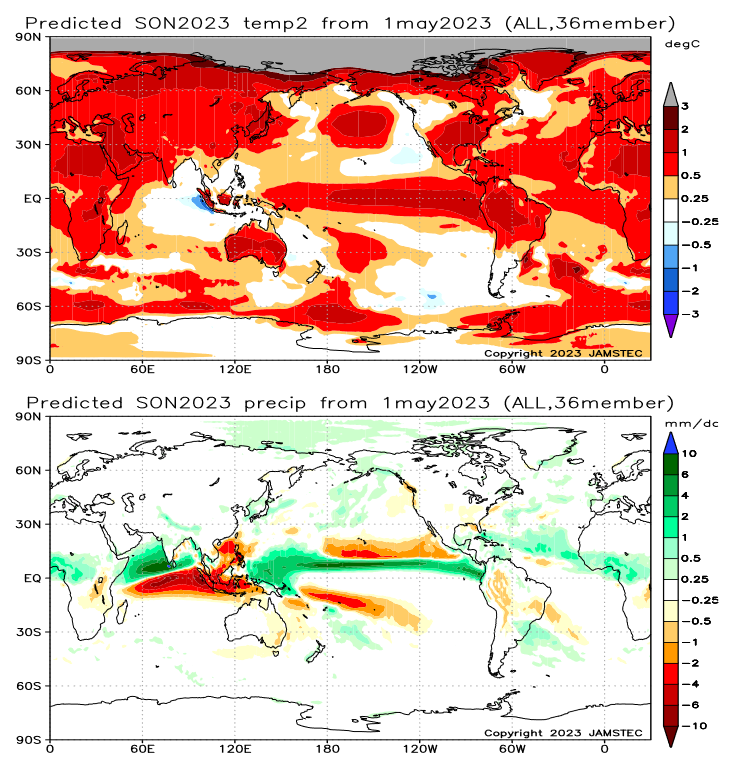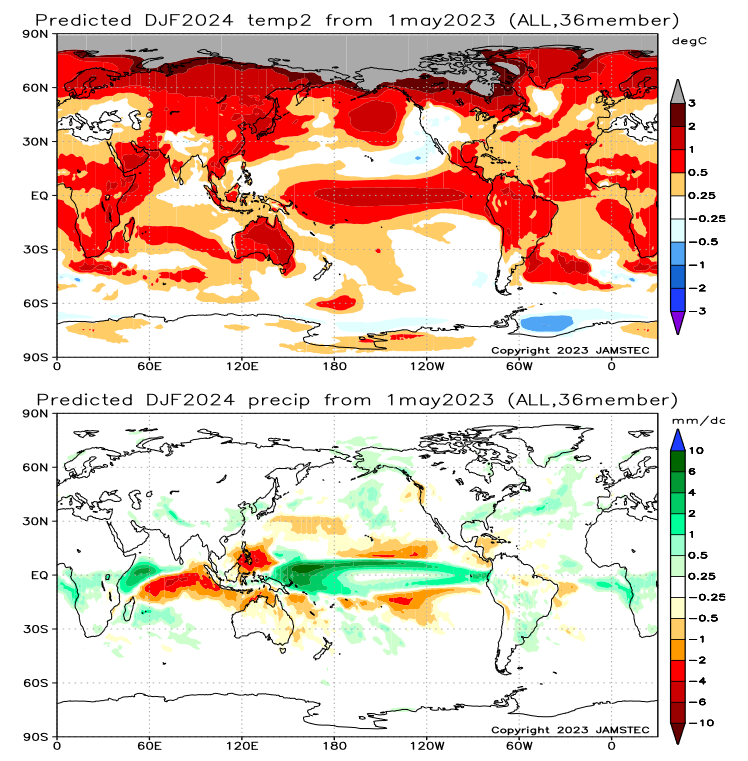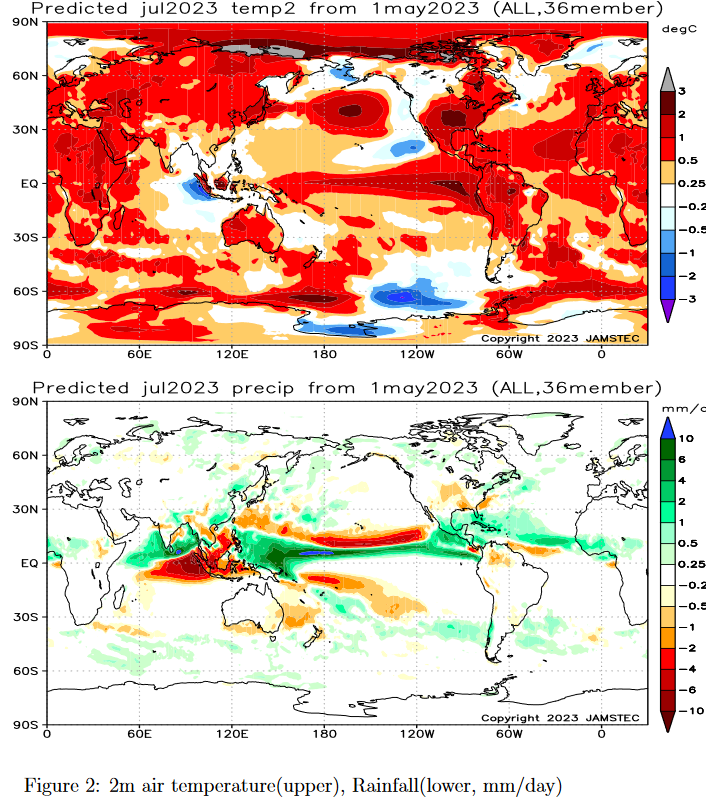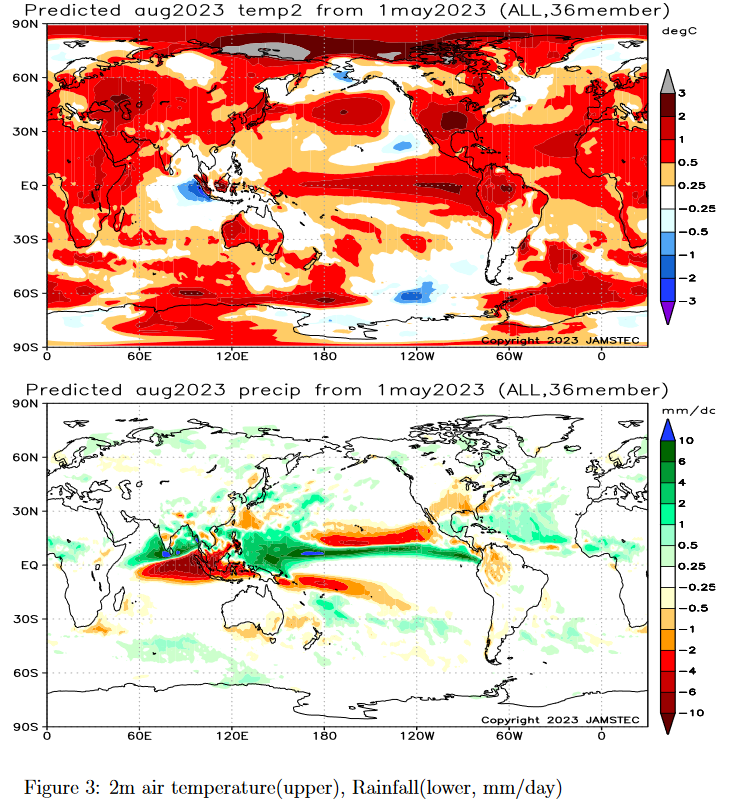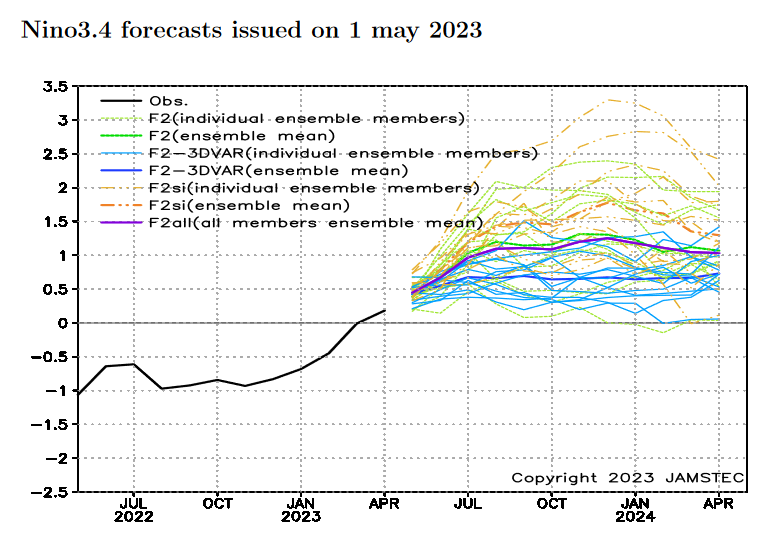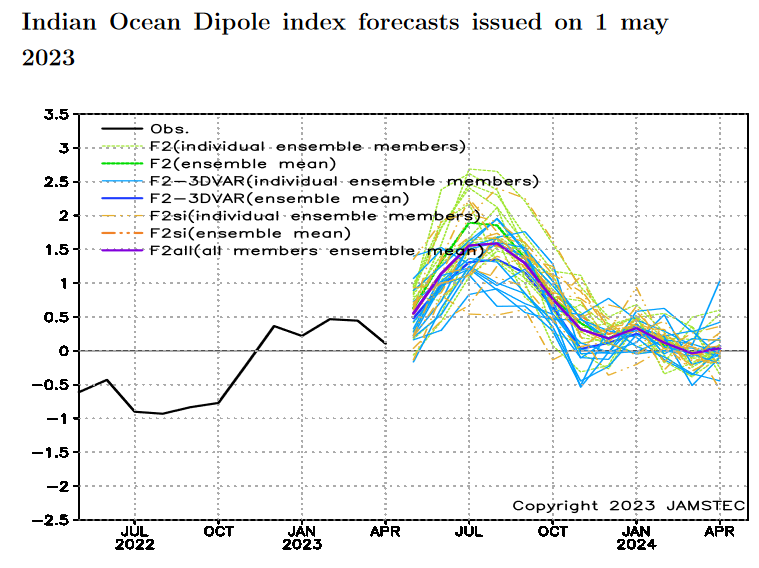The Japan Agency for Marine-Earth Science and Technology, or JAMSTEC, is a Japanese national research institute for marine-earth science and technology
From the JAMSTEC Discussion:
“Observation shows that the La Niña Modoki-like state persists. The SINTEX-F ensemble mean predicts that an El Niño will occur in June. However, there is a large uncertainty in the predictions of the amplitude, and the ensemble mean of the SINTEX-F2-3DVAR version predicts a relatively weak El Niño.” [This puts JAMSTEC in disagreement with NOAA and most other Meteorological Agencies]
Although it is a World forecast, it includes a forecast for North America since North America is part of the World.

First, we take a look at the forecasted sea surface temperature anomalies (SSTA). JAMSTEC starts by forecasting the SSTA and Nino 3.4 Index on the first day of the month and from there it takes their models about two weeks to produce their seasonal forecast. I received it from JAMSTEC on May 8, 2023.
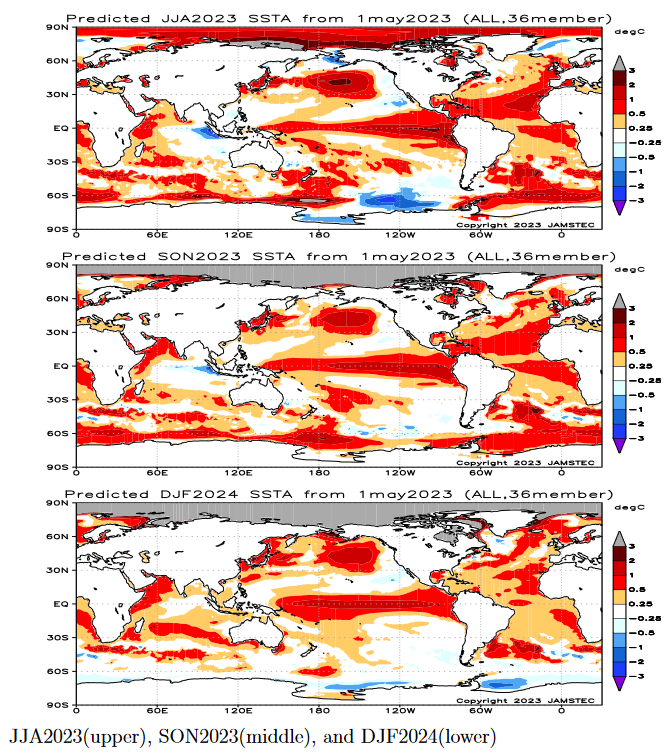
| This shows their forecast of sea surface temperature anomalies at three points in time. Notice the water along the Equator in the Pacific. Blue is cool (as an anomaly) and is associated with La Nina. Red is warm and is associated with El Nino. You can see the El Nino in all three time periods. It seems to be stronger in the 2nd and 3rd time periods. The warmest water shifts west in the third period exhibiting Modoki characteristics. [ I have similar information on their SSTA projections from NOAA but I usually do not include it in the article I write on the NOAA Seasonal Outlook because they do not seem to focus on it and their information does not extend as far into the future as does the information from JAMSTEC]. It is hard to find any blue in this set of forecasts. JAMSTEC uses the same definition of Normal (climatology as NOAA). The western extension of the warm anomaly explains the comment in the JAMSTEC commentary. They do a better job at characterizing La Ninas and El Ninos than NOAA. JAMSTEC provides me with a lot of other information that I do not include in my articles to keep them to a manageable size for readers. |
Then we look at three seasonal forecasts. JAMSTEC works with meteorological seasons and this month it lines up perfectly. This means we have three full seasons of forecasts this month.
| I do have some concerns about the JAMSTEC precipitation forecasts this month. There are large parts of the world where few anomalies are shown. That seems strange to me but that may be the case. The maps do seem to be consistent with the short discussion that they provided so I decided to publish this article. |

| This covers June/July/August (JJA 2023) which is meteorological Summer.
Here is the interpretation from the JAMSTEC Discussion shown below: “The SINTEX-F predicts that most parts of the globe will experience a hotter-than-normal condition in the boreal summer (austral winter), except for coastal Alaska.” “As regards the average rainfall in the boreal summer, a drier-than-normal condition is predicted for the southern U.S.A., Hawaii, the northern part of the South American continent, eastern Australia, some parts of East Africa, Indonesia, the Philippines, and most parts of Indochina. In contrast, the northeastern U.S.A., Mexico, Venezuela, Sri Lanka, central and western Africa, and some parts of coastal Indochina will experience a wetter-than-normal condition. In particular, we notice that Indonesia and eastern Australia may experience extremely drier than normal conditions, owing to the combination of the positive Indian Ocean Dipole and an El Niño. ” “The model predicts that most of Japan will be hotter and wetter than normal in the summer (except for Okinawa, which will be hotter and drier than normal).” |
| This covers September/October/November (SON 2023) which is meteorological Fall.
Here is the interpretation from the JAMSTEC Discussion shown below: “In the boreal autumn (austral spring), the model also predicts that almost all of the globe will experience a warmer-than-normal condition. The Arctic region will experience extremely hotter-than-normal conditions.” “In the boreal autumn (austral spring), a drier-than-normal condition is predicted for some parts of the U.S.A., Hawaii, some parts of the South American continent, eastern Australia, some parts of East Africa, Indonesia, the Philippines, and some parts of Indochina. In contrast, Alaska, Mexico, Venezuela, some parts of La Plata, New Zealand, the Horn of Africa, some parts of central and western Africa, some parts of western Europe, some parts of India, Sri Lanka, Nepal, Bhutan, and some parts of coastal Indochina will experience a wetter-than-normal condition.” “In autumn, the model also predicts that most of Japan will be hotter and Hokkaido will be wetter than normal.” |
| And above, December/January/February (DJF) 2023/2024 which is meteorological Winter. JAMSTEC does not provide its interpretation of its third season but one can observe it on the maps. |
Now I am going to provide their single-month forecasts for June, July, and August.
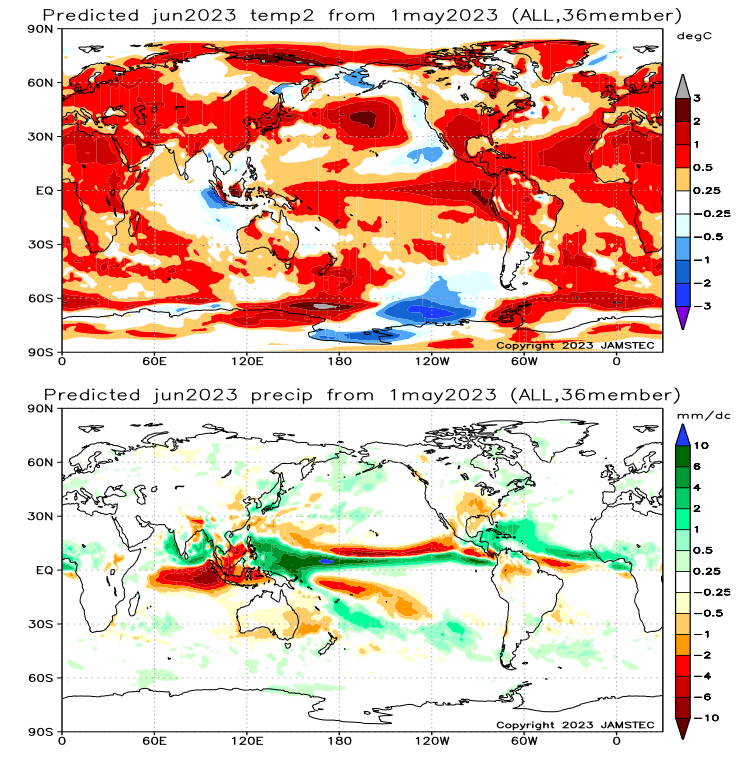
| The above is the single month of June 2023 |
| The above is the single month of July 2023 |
| The above is the single month of August 2023 |
Now we look at the key indices used by JAMSTEC in making their forecast. Perhaps I should have presented these first.
| It remains just under +0.5C att the start of May which means La Nina at least from the perspective of Sea Surface Temperature Anomalies. It rapidly moves above +0.5C i.e. into El Nino conditions. The JAMSTEC discussion now refers to the severity of the El Nino as difficult to predict but probably relatively weak. JAMSTEC now has a number of variations of their models. The blue line seems to be their preferred version. In this graph it shows just about +1.0C. This model forecasts through March of 2024. It seems to show El Nino through March of 2024 but a slight decline in the NINO 3.4 Index. |
–
| It looks like we will have a Positive IOD |
–
And here is the short JAMSTEC Discussion
ENSO forecast:
Observation shows that the La Niña Modoki-like state persists. The SINTEX-F ensemble mean predicts that an El Niño will occur in June. However, there is a large uncertainty in the predictions of the amplitude, and the ensemble mean of the SINTEX-F2-3DVAR version predicts a relatively weak El Niño.
Indian Ocean forecast:
The SINTEX-F ensemble mean predicts that a positive Indian Ocean Dipole event will occur in May. However, there is a large amount of uncertainty in the predictions of the amplitude.
Regional forecast:
The SINTEX-F predicts that most parts of the globe will experience a hotter-than-normal condition in the boreal summer (austral winter), except for coastal Alaska. In the boreal autumn (austral spring), the model also predicts that almost all of the globe will experience a warmer-than-normal condition. The Arctic region will experience extremely hotter-than-normal conditions.
As regards the average rainfall in the boreal summer, a drier-than-normal condition is predicted for the southern U.S.A., Hawaii, the northern part of the South American continent, eastern Australia, some parts of East Africa, Indonesia, the Philippines, and most parts of Indochina. In contrast, the northeastern U.S.A., Mexico, Venezuela, Sri Lanka, central and western Africa, and some parts of coastal Indochina will experience a wetter-than-normal condition. In particular, we notice that Indonesia and eastern Australia may experience extremely drier than normal conditions, owing to the combination of the positive Indian Ocean Dipole and the El Niño. In the boreal autumn (austral spring), a drier-than-normal condition is predicted for some parts of the U.S.A., Hawaii, some parts of the South American continent, eastern Australia, some parts of East Africa, Indonesia, the Philippines, and some parts of Indochina. In contrast, Alaska, Mexico, Venezuela, some parts of La Plata, New Zealand, the Horn of Africa, some parts of central and western Africa, some parts of western Europe, some parts of India, Sri Lanka, Nepal, Bhutan, and some parts of coastal Indochina will experience a wetter-than-normal condition.
The model predicts that most of Japan will be hotter and wetter than normal in the summer (except for Okinawa, which will be hotter and drier than normal). In autumn, the model also predicts that most of Japan will be hotter and Hokkaido will be wetter than normal.
–
| I hope you found this article interesting and useful |
